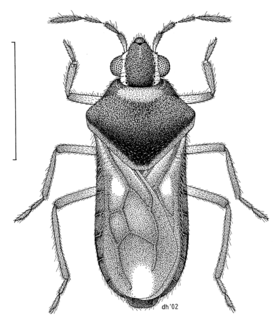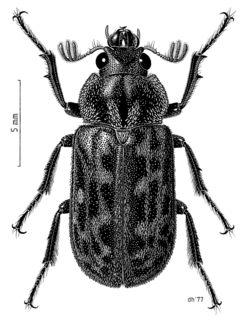
Veliidae is a family of gregarious predatory insects in the suborder Heteroptera. They are commonly known as riffle bugs, small water striders, or broad-shouldered water striders because the segment immediately behind the head is wider than the rest of the abdomen. The genus Rhagovelia is also referred to as a ripple bug.

The Gerromorpha comprise an infraorder of insects in the "true bug" order Hemiptera. These "typical" bugs are commonly called semiaquatic bugs or shore-inhabiting bugs. The Ochteroidea are also found in shore habitat, while the Gerromorpha are actually most often encountered running around on the water surface, being kept from sinking by surface tension and their water-repellent legs. Well-known members of the Gerromorpha are the namesake Gerridae.

Velvet water bugs are members of the family Hebridae. They are semiaquatic insects that live among moss or ponds with an abundance of vegetation, in which they prey on small arthropods. Velvet water bugs are the smallest of the Gerromorpha, and have an appearance of tiny veliids. Hebrids sometimes move across water surfaces, but walk or run rather than skate or scull on the surface.
Typhlocypris cavicola is a species of ostracod crustacean in the family Candonidae. It is endemic to Slovenia, where it is only known from Krka Cave.

The New Zealand Arthropod Collection is a collection of terrestrial invertebrates held by Maanaki Whenua – Landcare Research in Auckland, New Zealand. It specialises in the taxonomy and identification of indigenous and exotic invertebrate species in New Zealand, and is one of New Zealand's Nationally Significant Collections and Databases.

Microvelia is a genus of aquatic bugs in the family Veliidae. There are at least 230 described species in Microvelia.

Rhagovelia is a genus of smaller water striders in the family Veliidae. There are at least 390 described species in Rhagovelia.
Perittopus asiaticus is a species of riffle bug from Malaysia, China, and Thailand.
The Suwannee snapping turtle is a species of very large freshwater turtle in the family Chelydridae. This species is endemic to the southeastern United States, where it only inhabits the Suwannee River basin.
Rhagovelia espriella is a species of aquatic bug first found in La Espriella, Tumaco, Nariño, Colombia.
Rhagovelia magdalena is a species of aquatic bug first found in Vereda La Vega, Río Magdalena, Oporapa, Huila, Colombia.
Rhagovelia gastrotricha is a species of aquatic bug first found in Altaquer, Río Ñambí, Nariño, Colombia.
Rhagovelia choreutes is a species in the infraorder Gerromorpha, in the order Hemiptera . The distribution range of Rhagovelia choreutes includes Central America and North America.

Rhagovelia obesa is a species of smaller water striders in the family Veliidae. It is found in North America.
Microvelia americana is a species of smaller water strider in the family Veliidae. It is found in North America.
Microvelia pulchella is a species of smaller water strider in the family Veliidae. It is found in the Caribbean Sea, Central America, North America, and South America.
Phoreticovelia disparata, also called the Zeus bug, is a species of semi-aquatic bug from the family Veliidae with a unique form of sexual dimorphism. It is endemic to Australia (Queensland).

Microvelia macgregori is a species of true bug in the family Veliidae. It is semi-aquatic, living on the surface of water in freshwater habitats in New Zealand.
Microvelia karunaratnei is a species of smaller water strider in the family Veliidae. It has only been recorded in Sri Lanka and is one of the few veliid species known to inhabit tree holes.






